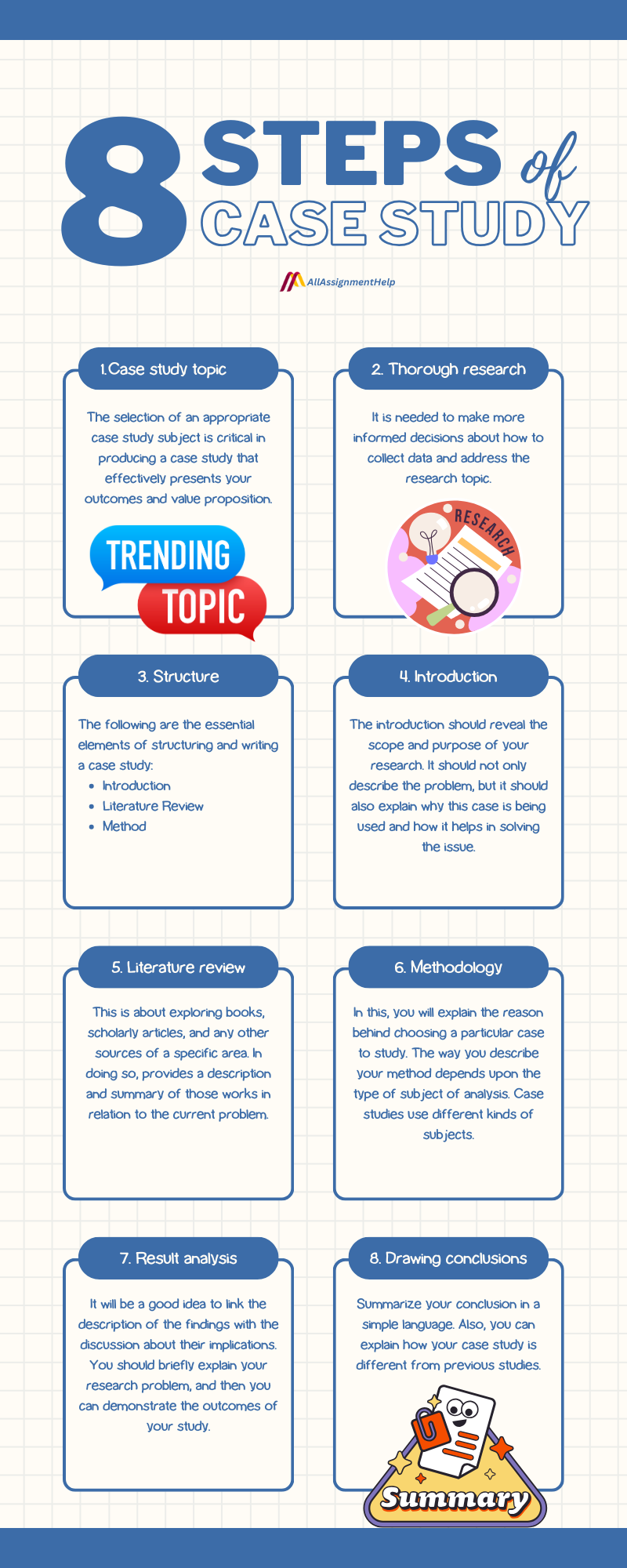Table of Contents
The purpose of this blog by All Assignment Help is to discuss a topic that troubles almost every student i.e. how to write a case study. A case study involves in-depth and detailed research of the case study. Moreover, it aims to guide the reader through a scenario in which an issue is raised, background information is supplied, and the solution is described, along with the methodology used to get at it. Furthermore, you can write a case study to inspire the reader to think of a solution on their own or to go over an existing solution. Case studies are always intended to provide the reader with experiences that are comparable to their own when researching the topic at hand.
Additionally, it involves research of its related conditions and requires thorough study and analysis of the case. Keep reading this article till the end for ideas on how to write a case study.
Simple 8 Steps to Write a Case Study
Case study can be intimidating if you do not know how to navigate through it properly. Hence, to make your writing journey easy, we have curated these simple eight steps to help you answer how to write a case study. However, if you want any help in writing your case study, you may also take case study assignment help from our experts. This could ease your burden to a great extent. Writing an excellent case study can be a challenging feat. But if you keep some essential points in mind, then the job will become easy for you.
Choosing the right case study subject
The selection of an appropriate case study subject is critical in producing a case study that effectively presents your outcomes and value proposition. Still, it’s not always simple to choose case study subjects. Considerations for several factors include:
- How pertinent the topic is to the people you intend to reach.
- The difficulty, solution, and result of the topic are all unique.
- How willing and available the subject is to take part in the case study.
- The subject’s standing and recognition in their field or sector.
- What effect the case study could have on the subject’s standing and connection?
In addition to this, a thorough analysis of a case can be based on the hypothesis. It could be that this new case study will reveal valuable insights and issues. Especially, those insights which have not been published in previous research. There are many assumptions which are based on previous research. However, with time those assumptions, sometimes become obsolete. Make sure you select a case through which you can gather crucial evidence. Evidence that challenges prevailing assumptions.
Also read: Case Study: Definition, Types, Use & Approach to Write a Case Study
Conducting thorough research
It is essential to have a strong research approach before you begin writing a quality case study. By doing this, you will be able to make more informed decisions about how to collect data and address the research topic. In order to perform research, you need reliable sources of data. Therefore, try to answer these questions to determine the most effective research plan and organize the collected data.
- Which problem or inquiry will this study try to answer?
- Which people are the study’s intended audience?
- How will this study be conducted?
- What or who are you hoping to study? An individual or a group.
- The time frame you have chosen to learn. State as it is now or as it has changed over time.
Moreover, depending on the kind of case study you are aiming for, you can choose between two major types of case study research methods, qualitative and quantitative. Furthermore, if you still require assistance with your problem, or how to write a case study then you can always hire our assignment help online service to get your case study done on time without much hassle.
Structuring your case study
The purpose of writing a case study is to investigate a particular case thoroughly. The thorough study includes revealing a new awareness of the research problem. In doing so, contributes new knowledge to what is already known. The following are the essential elements of structuring and writing a case study:
- Introduction
- Literature Review
- Method
Writing the introduction
The introduction should reveal the scope and purpose of your research. It should not only describe the problem, but it should also explain why this case is being used and how it helps in solving the issue. Moreover, describe your research problem and the method of analysis which would address the problem. In an introduction, you can explain how the above-said elements are linked together. Furthermore, the second thing which you can explain in an introduction is the significance of your case. You can tell how your chosen case is suitable for solving problems. Also,
- The next thing could be the background of a case study. With new insights, you can also explain the history of initial findings.
- Explain how your case study will help in expanding knowledge and understanding of a specific problem.
Once the introduction part is done, let us move to the next step of how to write a case study.
Also read: Deadlock in Operating Systems: A Brief Study

Presenting the literature review
This is about exploring books, scholarly articles, and any other sources of a specific area. In doing so, provides a description and summary of those works in relation to the current problem. In the literature review, you can highlight relevant works and their contribution. This could involve highlighting papers that have investigated the research challenge using a similar instance. Moreover, you can also explain why it’s important to use the same case (e.g. earlier studies were long ago developed).
A particular case may have several previous studies. There could be many unresolved issues that need to be addressed. Your present case study should help in resolving the existing conflicts. This, in turn, will assist in forming fresh insights. Summarize how your present case study helps to find new ways to understand the research problem. It includes identifying the loopholes in earlier studies. It also, includes how the current study helps in removing those loopholes.
Describing your methodology
The methodology is an integral part of how to write a case study. In this, you will explain the reason behind choosing a particular case to study. Also, you can highlight the strategy you have used to identify and decide that your case is appropriate in addressing the research problem. The way you describe your method depends upon the type of subject of analysis. Case studies use different kinds of subjects, read them below.
When the subject is an incident or event
The subject of analysis could be a rare or critical event, or it can be a regular event. The purpose of studying a rare event could be thinking about a broader research problem or testing a hypothesis. You can explain the reason for choosing this particular subject.
When your subject of analysis is a person
You can explain why you selected this specific person to be studied. You can also describe the experience this person is having which can advance understanding about the research problem. Consider what experience they have that makes them worthy of this study.
When your subject is a place
When a subject of a case study is a place, it must not only describe its various attributes relevant to the research problem (i.e., physical, social, cultural, economic, political, etc.) but also highlight the method which will illuminate new understanding about the research problem.
When your subject is a phenomenon
A phenomenon is anything which manifests itself. It also refers to a fact or occurrence that can be studied or observed. There are many phenomena which are not clearly understood. You can choose such a case which provides an insightful understanding of a particular phenomenon.
Analyzing the results
Now, it’s time to analyze the results which generally revolve around interpreting and drawing a conclusion about the key findings. Moreover, it will be a good idea to link the description of the findings with the discussion about their implications. You should briefly explain your research problem, and then you can demonstrate the outcomes of your study. Here, you can also define the meaning of your findings.
Furthermore, highlight your points which show the significance of your results. It rarely happens that your subject has not been studied previously. Try to find similar studies and try to form a link between your and earlier studies on the same issue. Also, it is essential to highlight the limitations of your study. Even after you have studied your subject thoroughly, there may still be many things which are left. Acknowledge those limitations and highlight questions that your research could not answer.
Also, writing a case study can be time and chances are your other academic responsibilities might go unnoticed. For example, if you are enrolled in an online class, you might miss your classes if you are intensely involved in writing your case study. In such a situation, you can hire an online class helper to handle your academic obligations for you on your behalf. In this way, you can take care of all your academic needs, from writing a case study to attending your online lectures.
Drawing conclusions
Here comes the last point of how to write a case study, the conclusion. It is a significant part of any case study. Summarize your conclusion in a simple language. Also, you can explain how your case study is different from previous studies. In conclusion, you will mention the most significant points of your research. The conclusion should briefly explain your research and the findings of the case study. However, in case of any writing trouble, you can always seek assistance from our assignment writing service.
In addition to this, there are some auxiliary parts of how to write a case study that you should not forget while composing your work. Adding these elements will only add volume to your work and make it relevant.
- Adding visual elements like charts, graphs, and images will make your work easy to understand and appealing.
- It is crucial to edit and proofread your case study to eliminate any potential mistakes.
- Do not forget to take good care of the formatting and citation guidelines.
Conclusion
A case study demands rigorous preparation, methodical data collecting, deliberate analysis, and a well-defined goal. While it may take some time, this study design is incredibly useful in research because of the rich, in-depth insights that a well-done case study can offer. You will have no trouble creating an engaging case study that adds significant insights to your field of study if you adhere to this guide and make use of its useful advice.
Frequently Asked Questions
| Question: What are the things to avoid while writing a case study? Answer: There are certain things that need to be avoided such as overgeneralization, failure to document limitations, and failure to extrapolate all potential consequences. |
| Question: Is a case study different from a research paper? Answer: Yes, both are different. Research papers, draw the reader’s attention to a specific issue. Whereas, a case study requires special attention to detail, investigating difficulties closely and in-depth using various research methodologies. |
| Question: How to create a title page of a case study? Answer: The format of your title page is determined by the citation style you use. However, a general title page contains 5-9 words in length, your name and contact information, and it should have the words “case study” in it. |
